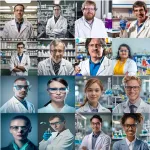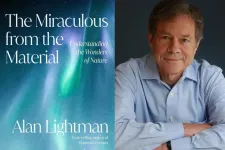Real-world chemists are more diverse than generative AI images suggest
2024-11-20
(Press-News.org) Asking children “What does a scientist look like?” now results in more illustrations of women and people of color than decades ago. But do generative artificial intelligence (AI) tools also depict the diversity among scientists? Researchers reporting in the Journal of Chemical Education prompted AI image generators for portraits of chemists. They found that none of the collections accurately represents the gender, racial or disability diversity among real chemists today.
Millions of images are being created by generative AI each day. And the output of these tools is only as good as their algorithms and the initial images used to train the large language models. Recently, researchers have found that AI image generators may produce content that’s not representative of reality — beyond bodily proportions that aren’t close to possible. For example, when a team prompted generative AI tools to produce images of people in various occupations, some perpetuated gender and racial stereotypes rather than reproducing the actual demographics of those workers. So, a team led by Valeria Stepanova, including Meagan Kaufenberg-Lashua, Joseph West and Jaime Kelly, wanted to see how well AI-generated portraits of chemists represent current demographic trends.
The researchers prompted four AI image generators for modern, portrait-style photographs of chemists in industry or academic occupations. Then, with the assistance of undergraduate students, the team assessed the gender and racial distribution as best they could within the 200-image collection. The entire AI collection had a male-female ratio similar to that of the U.S. National Science Foundation’s (NSF) 2021 demographic survey. The researchers also found that most of the generated images were of seemingly White people, which they say is representative of the U.S. chemistry field. But there was considerable variation in the results produced by the individual AI models. One tool generated more females than NSF data says is representative, and another created images only of males. Additionally, two models produced almost no people of color, yet one model generated primarily images of people of color. To the researchers’ surprise, none of the models produced images of chemists with visible disabilities.
Overall, the researchers say that this demonstration illustrates how different image-generating AI can amplify incorrect information about the diversity among chemists. They conclude their study by asking, “Are humans going to control the knowledge generated by AI, or will AI influence the knowledge of generations of people moving forward?”
There was no funding agency for this project.
###
The American Chemical Society (ACS) is a nonprofit organization chartered by the U.S. Congress. ACS’ mission is to advance the broader chemistry enterprise and its practitioners for the benefit of Earth and all its people. The Society is a global leader in promoting excellence in science education and providing access to chemistry-related information and research through its multiple research solutions, peer-reviewed journals, scientific conferences, e-books and weekly news periodical Chemical & Engineering News. ACS journals are among the most cited, most trusted and most read within the scientific literature; however, ACS itself does not conduct chemical research. As a leader in scientific information solutions, its CAS division partners with global innovators to accelerate breakthroughs by curating, connecting and analyzing the world’s scientific knowledge. ACS’ main offices are in Washington, D.C., and Columbus, Ohio.
Registered journalists can subscribe to the ACS journalist news portal on EurekAlert! to access embargoed and public science press releases. For media inquiries, contact newsroom@acs.org.
Note: ACS does not conduct research but publishes and publicizes peer-reviewed scientific studies.
Follow us: X, formerly Twitter | Facebook | LinkedIn | Instagram
END
[Attachments] See images for this press release:

ELSE PRESS RELEASES FROM THIS DATE:
2024-11-20
When we gaze at nature’s remarkable phenomena, we might feel a mix of awe, curiosity, and determination to understand what we are looking at. That is certainly a common response for MIT’s Alan Lightman, a trained physicist and prolific author of books about physics, science, and our understanding of the world around us.
“One of my favorite quotes from Einstein is to the effect that the most beautiful experience we can have is the mysterious,” Lightman says. “It’s the fundamental emotion that is the cradle of true art and true science.”
Lightman explores those concepts in his latest book, “The ...
2024-11-20
Today, Nature and other Nature Portfolio journals published a collection of more than 40 peer-reviewed papers marking a milestone toward researchers’ understanding of the human body in health and disease and the development of the first draft of the Human Cell Atlas (HCA). The Human Cell Atlas is an international community whose mission is to align groups engaged in creating comprehensive reference maps of all human cells — the fundamental units of life — as a basis for understanding human health and for diagnosing, monitoring, and treating disease. The Chan Zuckerberg Initiative (CZI) is one ...
2024-11-20
Rivers and streams serve as critical connectors across vast geographical landscapes, trickling out of tucked-away headwaters and snaking thousands of miles toward oceans and deep seas. These waterways directly impact human and environmental health, agriculture and energy production, and supply the United States with two-thirds of its drinking water. And yet, compared with other larger waterbodies, the microbiology of rivers is relatively understudied.
A Colorado State University-led team of scientists have contributed to changing that — detailing for the first time both broad and specific information ...
2024-11-20
The most comprehensive cell map of the human gut to date has been created by combining spatial and single-cell data from 1.6 million cells.
Mapping the cells of the gut can provide us with further insights into what happens in conditions such as bowel cancer and Inflammatory Bowel Disease (IBD). Using this atlas, researchers from the Wellcome Sanger Institute and collaborators uncovered a new role of a specific gut cell, highlighting its contributions to a cycle of inflammation in some individuals, possibly causing pain and distress.
The study, published today (20 November) in Nature, details how the team ...
2024-11-20
Researchers at Karolinska Institutet have found a molecule that can both help the intestines to heal after damage and suppress tumour growth in colorectal cancer. The discovery could lead to new treatments for inflammatory bowel disease (IBD) and cancer. The results are published in the journal Nature.
Many patients with inflammatory bowel disease (IBD) such as Crohn’s disease or ulcerative colitis do not respond to available treatments, highlighting the need to identify novel therapeutic strategies. In a new study published in Nature, researchers propose that promoting ...
2024-11-20
About The Study: In this cross-sectional study, postpartum depression (PPD) diagnosis increased significantly across all racial and ethnic groups and body mass index (BMI) categories over the past decade. While rising PPD may reflect improved screening and diagnosis practices, the persistently high rates highlight the need to develop and implement interventions to prevent the condition while expanding efforts to mitigate the impact of PPD on maternal and child health.
Corresponding Author: To contact the corresponding author, Darios Getahun, MD, PhD, ...
2024-11-20
About The Study: The findings of this population-based matched cohort study suggest that individuals born preterm were at an increased risk of death from birth until their third and fourth decades of life, with higher risks as gestational age decreased. Some of these associations may have been partly due to underlying health determinants that affected preterm birth and mortality. These findings suggest that preterm birth should be recognized as a risk factor for mortality and could inform preventive strategies.
Corresponding Author: To contact the corresponding author, Asma M. Ahmed, PhD, MD, MPH, email asahmed@wakehealth.edu.
To access ...
2024-11-20
New Haven, Conn. — Wings may be the obvious choice when studying the connection between dinosaurs and birds, but a pair of Yale paleontologists prefer drumsticks. That part of the leg, they say, is where fibular reduction among some dinosaurs tens of millions of years ago helped make it possible for peacocks to strut, penguins to waddle, and turkeys to trot.
“A good way to understand this is to take a look at drumsticks, like the ones people eat on Thanksgiving,” said Armita Manafzadeh, lead author ...
2024-11-20
LA JOLLA (November 20, 2024)—More than 3 billion years ago, on an Earth entirely covered with water, photosynthesis first evolved in little ancient bacteria. In the following many millions of years, those bacteria evolved into plants, optimizing themselves along the way for various environmental changes. This evolution was punctuated around 30 million years ago with the emergence of a newer, better way to photosynthesize. While plants like rice continued using an old form of photosynthesis known as C3, others like corn and sorghum developed a newer and more efficient version called C4.
There are now more than 8,000 different C4 plant ...
2024-11-20
By creating the first spatial atlas of the developing human thymus, a vital organ that trains immune cells to protect against infections and cancer, scientists have discovered that the foundation for lifelong immunity is established earlier than previously thought.
Researchers from the Wellcome Sanger Institute and their collaborators at Ghent University, Belgium, the National Institutes of Health’s National Institute of Allergy and Infectious Diseases and others, uncovered key differences in the development of immune cells. This understanding could help scientists ...
LAST 30 PRESS RELEASES:
[Press-News.org] Real-world chemists are more diverse than generative AI images suggest





